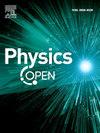Radiation shielding properties of selenium-based lead borate PbO-SeO2-B2O3 glass for X-ray and gamma radiation
IF 1.4
Q2 Physics and Astronomy
引用次数: 0
Abstract
The radiation shielding properties of selenium-based lead borate glass systems xSeO2 + (25-x) B2O3 + 75PbO (x = 0, 0.2, 0.4, 0.6) were investigated using the MCNPx simulation and the Phy-x/PSD program in the energy range of 0.015–15 MeV. The density increased with the substitution of SeO2 contents due to the replacement of B2O3 (69.62 g/mol) by SeO2 (110.96 g/mol) in the host glass, enhancing the glass compactness. In addition, the Se2+ takes up substitute regions in the structure, which lowers the molar volume and contributes to stiffness and stability. The samples' mass attenuation coefficient (MAC) and linear attenuation coefficient (LAC) decreased with increasing energy. As energy increases, more radiation penetrates, leading to a decrease in the MAC and LAC. At 0.1 MeV, the MAC values for the S4 sample, with a density of 5.702 g/cm3, are 4.68552 cm2/g, whereas at 0.5 MeV, they are 0.14928 cm2/g, indicating more attenuation with increasing energy. The HVL ranges from 0.00129 to 2.41029 cm, while the TVL ranges from 0.00429 to 8.00682 cm, respectively. The S1 glass exhibited higher HVL values, whereas the S4 sample showed the lowest HVL values, indicating it is the most effective attenuation glass. The effective atomic number (Zeff) varies randomly with energy, representing different photon-matter interactions in specific energy ranges. The S4 glass exhibits the highest value of Zeff at 15 MeV, ranging from 79.65085 to 52.07709. The results confirm that the investigated glass samples can be a radiation shielding material for X-rays rooms and γ-rays in medicine, cosmology, hospitals, and nuclear physics.
硒基硼酸铅PbO-SeO2-B2O3玻璃对x射线和γ射线的辐射屏蔽性能
利用MCNPx模拟和Phy-x/PSD程序研究了硒基硼酸铅玻璃体系xSeO2 + (25-x) B2O3 + 75PbO (x = 0,0.2, 0.4, 0.6)在0.015-15 MeV能量范围内的辐射屏蔽性能。由于主体玻璃中的B2O3 (69.62 g/mol)被SeO2 (110.96 g/mol)取代,使得密度随着SeO2含量的增加而增加,增强了玻璃的致密性。此外,Se2+在结构中占据替代区域,降低了摩尔体积,有助于刚度和稳定性。样品的质量衰减系数(MAC)和线性衰减系数(LAC)随能量的增加而减小。随着能量的增加,更多的辐射穿透,导致MAC和LAC的减少。在0.1 MeV时,密度为5.702 g/cm3的S4样品的MAC值为4.68552 cm2/g,而在0.5 MeV时,MAC值为0.14928 cm2/g,随着能量的增加衰减更大。HVL范围为0.00129 ~ 2.41029 cm, TVL范围为0.00429 ~ 8.00682 cm。S1玻璃具有较高的HVL值,而S4样品具有最低的HVL值,表明它是最有效的衰减玻璃。有效原子序数(Zeff)随能量随机变化,表示特定能量范围内不同的光子与物质相互作用。S4玻璃在15 MeV时Zeff值最高,范围为79.65085 ~ 52.07709。结果证实,所研究的玻璃样品可以作为医学、宇宙学、医院和核物理学中x射线室和γ射线的辐射屏蔽材料。
本文章由计算机程序翻译,如有差异,请以英文原文为准。
求助全文
约1分钟内获得全文
求助全文
来源期刊

Physics Open
Physics and Astronomy-Physics and Astronomy (all)
CiteScore
3.20
自引率
0.00%
发文量
19
审稿时长
9 weeks
 求助内容:
求助内容: 应助结果提醒方式:
应助结果提醒方式:


